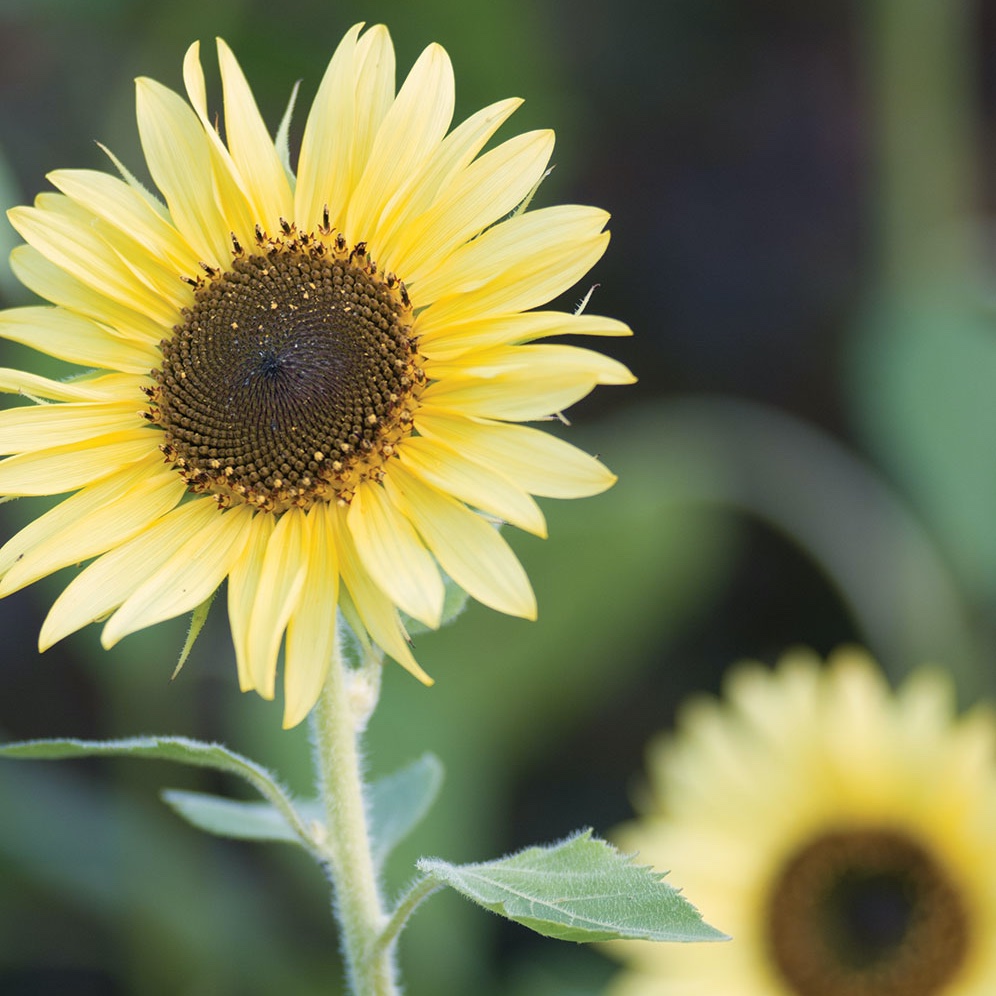
Photo by Mark Fonville
Each year, as I stare into a handful of sunflower seeds, it’s exciting to imagine the beauty and joy each one has in store. Sunflowers are simple, bold, and easy to grow. All that’s required are a few seeds, good garden soil, and lots of sun. Nature will do the rest and reward you with an abundance of blooms from late spring through fall.
It wasn’t until I spent time knocking around old estates and villages in Tuscany one summer that I fully appreciated the wide range of sunflower varieties. This is where I saw my first ‘Italian White’ and others of an almost mahogany color.
I usually found these heirloom varieties off the beaten path in the small garden plots of hillside towns, growing among the clipped rosemary parterres, tomatoes, squashes, and arugula. The randomness of sunflowers dotted about added to the charm of these gardens. That experience sent me home with zeal to plant every variety I could get my hands on.
It’s easy to understand how their striking blooms and long, strong stems make sunflowers a flower arranger’s dream. If, like me, you’re prone to cutting and bringing everything you grow into the house, it’s important to know that some varieties are better suited for the vase than others.
Recent newcomers outperform some of the old heirloom types, charming as they may be. I have come to lean heavily on ‘Vincent’s Fresh’ and ‘Vincent’s Choice’ for use in the house and for events because of their almost 10-day vase life as a cut flower. I also continue to make plenty of room for the heirlooms because of the diversity they bring to the farm, both visually and ecologically.
The sunflower’s range of varieties goes well beyond color and shape. Some bloom on single stems, others tend to branch, and then there are those that stand like behemoths in the garden. Giant sunflowers, such as ‘Mammoth Russian’ or the colossal ‘Sunzilla,’ reach heights of 15 feet with 20 -inch seed heads. On the other end of the scale are the dwarfs, like the adorable ‘Teddy Bear,’ growing 2 to 3 feet tall with soft, pillowy blooms.
ALLEN’S FAVORITE SUNFLOWER VARIETIES
Click image to enlarge.

Photo courtesy of P. Allen Smith
'Vincent's Choice' sunflower

Photo courtesy of P. Allen Smith
'Vincent's Fresh' sunflower

Photo courtesy of P. Allen Smith
'Velvet Queen' sunflower

Photo courtesy of P. Allen Smith
'Cherry Rose' sunflower

Photo courtesy of P. Allen Smith
'Teddy Bear' sunflowers

Photo courtesy of P. Allen Smith
'Moonshine' sunflower
GROWING LARGE SUNFLOWERS
If you want to grow the really large flowers, note that they need extra support as their heavy heads mature. Planting them along a fence, wall, or trellis makes them less vulnerable to heavy rain and high winds. We learned this the hard way after a sudden thunderstorm leveled an entire bed of ‘Mammoth Russians,’ knocking their faces flat to the ground. Not to be defeated, we gathered them and hung them upside down in the drying shed for use in autumn arrangements.

Photo by Ganeshkumar Durai | Shutterstock
'Russian Mammoth' sunflowers live up to their name, growing up to 12 feet tall with proper support.
SUNFLOWER BENEFITS
We always plant extra sunflowers since they are beneficial to the bee and pollinator population and support bird life. Over the years, I’ve seen an increase of indigo buntings, cardinals, red-bellied woodpeckers, and other native birds. These are the delightful yet unintended benefits of growing sunflowers.
These life-giving plants offer so much to the ecosystems around us. And their radiance delights us, whether shining through in the garden or as a bouquet in our homes.
SUNFLOWER TRIVIA
- Sunflower seed shells contain a substance that’s toxic to grass. Harvest the sunflower heads before the seeds fall out, or plant them in a place where you won’t mind if the grass is stunted or killed.
- Sunflowers are not picky about soil type, but the healthier your soil, the better the blooms.
- The tall sunflower varieties can shade other plants nearby, so be mindful of what flowers you plant around your sunflowers.

Photo by Mark Fonville
By P. Allen Smith
P. Allen Smith, an author, television host, and flower enthusiast, is one of America’s most recognized garden and design experts. Smith uses his Arkansas home, Moss Mountain Farm, as an epicenter for promoting the local food movement, organic gardening, and the preservation of heritage poultry breeds. He created the farm to serve as a place of inspiration, education, and conservation, and he offers tours to visitors from around the country. For reservations, visit pallensmith.com/tours.




